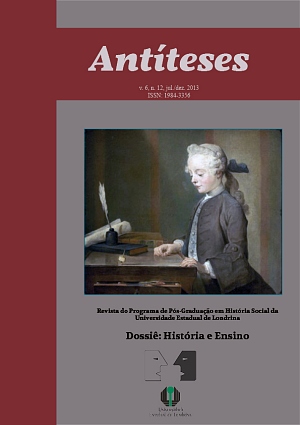O uso de fontes em sala de aula: a obra de Maria Firmina dos Reis (1859) como mediadora no estudo da escravidão negra no Brasil
DOI:
https://doi.org/10.5433/1984-3356.2013v6n12p577Palabras clave:
Ensino de história, Literatura, Escravidão, Literacia históricaResumen
Partindo do pressuposto de que a escola também produz conhecimento histórico, discute-se a importância do uso de fontes em sala de aula, uma das premissas para a construção da literacia histórica, apresentando como proposta de trabalho o uso do romance “Úrsula” de Maria Firmina dos Reis (1859), como uma rica fonte histórica ao apresentar uma visão de escravo como sujeito histórico. Maria Firmina dos Reis aventurou-se a escrever dentro das possibilidades que a sociedade brasileira do século XIX impunha à época, driblou as agruras de seu tem¬po e em 1859 publica seu romance “Úrsula”, obra singular por ser composta por uma mulher de descendência africana na qual se evidencia a condição de desigualdade a que as mulheres, africanos e seus descendentes estavam submetidos no Brasil oitocentista, em decorrência do regime patriarcal. Considera-se o conhecimento prévio sobre o tema, apresentado por alunos de Ensino Médio oriundos de dois colégios públicos localizados em Londrina (PR), visto que o novo conhecimento se origina a partir de conhecimentos anteriores, apontando, entre outros, a importância das telenovelas, dos materiais didáticos nas representações encontradas. Apresenta-se uma discussão do debate nacional sobre escravidão negra no Brasil onde o escravo passa a ser visto como um sujeito histórico, a partir de novas abordagens balizadas em fontes e pesquisas documentais renovadas evidenciando a relativa autonomia de africanos e seus descendentes em cativeiro e os avanços na luta por uma história afro-brasileira, através da lei 10.639/03 que tornou obrigatório no currículo escolar da educação básica o estudo da História da África. Discute-se emprego de fontes históricas em sala de aula de forma crítica, contribuindo no processo de ensino e aprendizagem que tem como pressuposto a pesquisa, o debate, a formação do espírito crítico e inventivo, introduzindo os alunos no fazer historiográfico e/ou na construção do conhecimento histórico. Inferem-se os resultados positivos ao utilizar a obra de Firmina na construção de uma visão do escravo como agente histórico, permeando o estudo da escravidão negra no Brasil, por direções mais gerais tornando o aprendizado mais produtivo e desafiador. Em suma infere-se que a história e a literatura, no processo de ensino, possibilitam espaço privilegiado de produção do conhecimento histórico escolar.Descargas
Citas
Descargas
Publicado
Cómo citar
Número
Sección
Licencia
A Revista Antíteses adota a Licença Creative Commons Attribution 4.0 International, portanto, os direitos autorais relativos aos artigos publicados são do(s) autor (es), que cedem à Revista Antíteses o direito de exclusividade de primeira publicação.
Sob essa licença é possível: Compartilhar - copiar e redistribuir o material em qualquer suporte ou formato. Adaptar - remixar, transformar, e criar a partir do material, atribuindo o devido crédito.
https://creativecommons.org/licenses/by/4.0/














